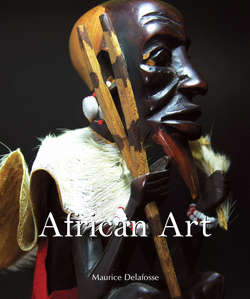Читать книгу African Art - Maurice Delafosse - Страница 15
На сайте Литреса книга снята с продажи.
Development of Negro Civilisations in Antiquity
Abyssinian Semites and the Beni-Israel
ОглавлениеIn East Africa, another civilisation of equally Semitic origin accomplished an analogous work among the Negroes and Negroid populations of its neighbourhood. I speak of the Abyssinian civilisation which, born in the south of the Arabian peninsula, passed into Africa with Yemenite immigrants at a very remote epoch and developed in contact with Egyptian civilisation, on which, in turn, it did not fail to react more than once. It introduced among the, more or less, mixed Negroes on the coast of the Red Sea, as well as among the Negroes scattered in eastern Sudan and between the mountains of Ethiopia and the Great Lakes, a transformation comparable to that which the Phoenician colonies of the Mediterranean produced from afar among the Negroes of central and western Sudan.
Local traditions have conserved the memory of other Semites, whom they call by the name of Israelites (Beni-Israel), without our being able to decide whether this name is of Muslim importation and therefore relatively recent, or if it really answers to the origin of this mysterious element. It is very possible, indeed, that the Semites in question came from the land of Abraham and were a branch of that population, in part Hebraic, whose astonishing destinies have not troubled Bossuet alone. Should we relate them to the Hebrews whom Joseph, son of Israel, brought to Egypt and who did not all return to the Holy Land with Moses, a certain number, on the contrary, making their way towards the west? Should we see in them the remains of those Hyksos mentioned in the Egyptian annals who, after all, were perhaps not distinct from the Hebrews of Joseph? Should they be identified with the Jews who, as a consequence of religious quarrels, emigrated from Tripolitania towards the end of the 1st century CE in the direction of the Aïr Mountains and towards the beginning of the following century in that of Tuat and who afterwards did not leave any real historical traces of their passage? Should we admit several successive migrations, the first of which goes back to the epoch of Moses and the dispersion of the Hyksos, that is, to about the 16th century BC, and the last of which are as recent as the 1st century CE?
However it be, and whatever name be given to the so-called “Beni-Israel”, it appears very certain that they were Semites who were at once shepherds, farmers, and artisans of a very advanced civilisation, who were not content, like their congeners of Carthage and Abyssinia, to merely have commerce with the Negroes and to promote the development of their civilisation by radiation. Instead, they lived in large groups within the country of the Negroes, or at least at the northern limits of this country, bringing with them the zebu or humped ox and the wool-bearing sheep; constructing in Sudan houses of masonry and wells cemented by a special process; introducing the arts of cattle raising and green gardening; contributing in a certain measure to the population of the Sahel and the Massina and to the hybridisation of the Negro populations already settled in these regions, forming perhaps the kernel of pastoral tribes who, under the name of Fulani, as we call them, or Fulbe, as they call themselves, later spread out from the Sahel and the Massina on the one side as far as the Atlantic and on the other beyond Lake Chad, finally creating in the west of Timbuktu, at Ghana, a State whose masters they long remained and which may be considered the cradle and the model of that which has been the most perfected in the civilisations of the Negroes of Africa.
Without either wishing or being able to commit myself on the mystery which up to the present surrounds the origin of these “Beni-Israel”, or pretended such, the role which they played in Negro Africa, or at least the one that local tradition attributes to them, seems to me to be too considerable to be passed over in silence. Perhaps, after all, it is to them, rather than to the Carthaginians or concurrently with the latter, that we ought to attribute the importation into the Sudanese languages of the words of ancient Semitic origin mentioned above.
Go gé mask (Dan).
Wood, metal, and hair, height: 26 cm.
Private collection.
Talismans have been placed atop this beautiful go gé mask. It is a perfect example of the refined beauty of Dan art that was only used for ceremonies which were linked to the funerals of important chiefs.
Mupo statue (Bamileke).
Cameroon.
Wood, height: 31.5 cm.
Magical statues, often in the shape of pregnant women with large stomachs as an obvious sign of fertility, were meant to conjure spells. They are commonly used in the southwest area of the Bamileke high plateaux. In addition to female fertility, the sculptor wanted to evoke meditation and wisdom as security for the continuation of chiefdom. Mupo were available in different sizes; the tallest, as seen here (from the Batié area, Bamunam, eastern Bangwa), were exposed in the courtyard before rituals, while the smaller ones were held during communal propitiatory dances.
Statue (Pre-Bembe).
Democratic Republic of the Congo.
Wood, height: 54 cm.
S. & J. Collection.
Often mixed by historical disorder, various stylistically close statues were created by the western populations of Lake Tanganyika – Hemba, Bembe, Boyo, Hhoombo, Tabwa, Bwile, etc., and dedicated to their ancestors, who played an important social role. Ancestral figures of dead chiefs or dignitaries were placed in funerary huts or burial boxes and were meant to protect the clan.
Sculpture (Nok), c. 500 BCE-50 °CE.
Terracotta, 50 cm.
Musée du quai Branly, Paris.
